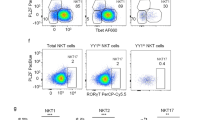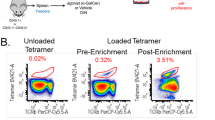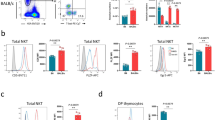Abstract
Natural killer (NK) cells are critical for both innate and adaptive immunity1,2. The development of NK cells requires interactions between their progenitors and the bone-marrow microenvironment3,4,5,6; however, little is known about the molecular nature of such interactions. Mice that do not express the transcription factor interferon-regulatory factor-1 (IRF-1; such mice are IRF-1−/− mice) have been shown to exhibit a severe NK-cell deficiency7,8. Here we demonstrate that the lack of IRF-1 affects the radiation-resistant cells that constitute the microenvironment required for NK-cell development, but not the NK-cell progenitors themselves. We also show that IRF-1−/− bone-marrow cells can generate functional NK cells whencultured with the cytokine interleukin-15 (9-12) and that the interleukin-15 gene is transcriptionally regulated by IRF-1. These results reveal, for the first time, a molecular mechanism by which the bone-marrow microenvironment supports NK-cell development.
This is a preview of subscription content, access via your institution
Access options
Subscribe to this journal
Receive 51 print issues and online access
$199.00 per year
only $3.90 per issue
Buy this article
- Purchase on Springer Link
- Instant access to full article PDF
Prices may be subject to local taxes which are calculated during checkout




Similar content being viewed by others
References
Trinchieri, G. Biology of natural killer cells. Adv. Immunol. 47, 187–376 (1989).
Scott, P. & Trinchieri, G. The role of natural killer cells in host–parasite interactions. Curr. Opin. Immunol. 7, 34–40 (1995).
Haller, O. & Wigzell, H. Suppression of natural killer cell activity with radioactive strontium: effector cells are marrow dependent. J. Immunol. 118, 1503–1506 (1977).
Seaman, W. E., Gindhart, T. D., Greenspan, J. S., Blackman, M. A. & Talal, N. Natural killer cells, bone, and the bone marrow: studies in estrogen-treated mice and in congenitally osteopetrotic (mi/mi) mice. J. Immunol. 122, 2541–2547 (1979).
Kumar, V., Ben-Ezra, J., Bennett, M. & Sonnenfeld, G. Natural killer cells in mice treated with 89strontium: normal target-binding cell numbers but inability to kill even after interferon administration. J. Immunol. 123, 1832–1838 (1979).
Hackett, J. J, Bennett, M. & Kumar, V. Origin and differentiation of natural killer cells. I. Characteristics of a transplantable NK cell precursor. J. Immunol. 134, 3731–3738 (1985).
Duncan, G. S., Mittrücker, H.-W., Kägi, D., Matsuyama, T. & Mak, T. W. The transcription factor interferon regulatory factor-1 is essential for natural killer cell function in vivo. J. Exp. Med. 184, 2043–2048 (1996).
Taki, S. et al. Multistage regulation of Th1-type immune responses by the transcription factor IRF-1. Immunity 6, 673–679 (1997).
Giri, J. G. et al. Utilization of the β and γ chains of the IL-2 receptor by the novel cytokine IL-15. EMBO J. 13, 2822–2830 (1994).
Grabstein, K. H. et al. Cloning of a T cell growth factor that interacts with the β chain of the interleukin-2 receptor. Science 264, 965–968 (1994).
Carson, W. E. et al. Interleukin (IL) 15 is a novel cytokine that activates human natural killer cells via components of the IL-2 receptor. J. Exp. Med. 180, 1395–1403 (1994).
Tagaya, Y., Bamford, R. N., DeFilippis, A. P. & Waldmann, T. A. IL-15: a pleiotropic cytokine with diverse receptor/signaling pathways whose expression is controlled at multiple levels. Immunity 4, 329–336 (1996).
Matsuyama, T. et al. Targeted disruption of IRF-1 or IRF-2 results in abnormal type I IFN gene induction and aberrant lymphocyte development. Cell 75, 83–97 (1993).
Tanaka, T. et al. Selective long-term elimination of natural killer cells in vivo by an anti-interleukin 2 receptor β chain monoclonal antibody in mice. J. Exp. Med. 178, 1103–1107 (1993).
Rolink, A. et al. Asubpopulation of B220+ cells in murine bone marrow does not express CD19 and contains natural killer cell progenitors. J. Exp. Med. 83, 187–194 (1996).
DiSanto, J. P., Muller, W., Guy-Grand, D., Fischer, A. & Rajewsky, K. Lymphoid development in mice with a targeted deletion of the interleukin 2 receptor γ chain. Proc. Natl Acad. Sci. USA 92, 377–381 (1995).
Ohbo, K. et al. Modulation of hematopoiesis in mice with a truncated mutant of the interleukin-2 receptor γ chain. Blood 87, 956–967 (1996).
Suzuki, H., Duncan, G. S., Takimoto, H. & Mak, T. W. Abnormal development of intestinal intraepithelial lymphocytes and peripheral natural killer cells in mice lacking the IL-2 receptor β chain. J. Exp. Med. 185, 499–505 (1997).
DiSanto, J. P. Shared receptors, distinct functions. Curr. Biol. 7, R424–R426 (1997).
Mrozek, E., Anderson, P. & Caligiuri, M. A. Role of interleukin-15 in the development of human CD56+ natural killer cells from CD34+ hematopoietic progenitor cells. Blood 87, 2632–2640 (1996).
Puzanov, I. J., Bennett, M. & Kumar, V. IL-15 can substitute for the marrow microenvironment in the differentiation of natural killer cells. J. Immunol. 157, 4282–4285 (1996).
Anderson, D. M. et al. Chromosomal assignment and genomic structure of IL-15. Genomics 25, 701–706 (1995).
Tanaka, N., Kawakami, T. & Taniguchi, T. Recognition DNA sequences of interferon regulatory factor 1 (IRF-1) and IRF-2, regulators of cell growth and the interferon system. Mol. Cell. Biol. 13, 4531–4538 (1993).
Bamford, R. N., Battiata, A. P., Burton, J. D., Sharma, H. & Waldmann, T. A. Interleukin (IL) 15/IL-T production by the adult T-cell leukemia cell line HuT-102 is associated with a human T-cell lymphotrophic virus type I region/IL-15 fusion message that lacks many upstream AUGs that normally attenuates IL-15 mRNA translation. Proc. Natl Acad. Sci. USA 93, 2897–2902 (1996).
Taniguchi, T., Lamphier, M. S. & Tanaka, N. IRF-1: the transcription factor linking the interferon response and oncogenesis. Biochim. Biophys. Acta 1333, M9–M17 (1997).
Dalton, D. K. et al. Multiple defects of immune cell function in mice with disrupted interferon-γ genes. Science 259, 1739–1742 (1993).
Huang, S. et al. Immune response in mice that lack the interferon-γ receptor. Science 259, 1742–1745 (1993).
Bendelac, A., Rivera, M. N., Park, S. H. & Roark, J. H. Mouse CD1-specific NK1 T cells: development, specificity, and function. Annu. Rev. Immunol. 15, 535–562 (1997).
Rodewald, H. R. et al. Apopulation of early fetal thymocytes expressing FcγRII/III contains precursors of T lymphocytes and natural killer cells. Cell 69, 139–150 (1992).
Tan, R. S., Taniguchi, T. & Harada, H. Identification of the lysyl oxidase gene as target of the antioncogenic transcription factor, IRF-1, and its possible role in tumor supression. Cancer Res. 56, 2417–2421 (1996).
Acknowledgements
We thank N. Tanaka, M. Sato and R. Perlmutter for discussion and M. S. Lamphier for critically reading the manuscript. This work was supported by the Japan Society for the Promotion of Sicnece Research for the Future Program, by a special grant for Advanced Research on Cancer from the Ministry of Education, Science and Culture of Japan, and by the Human Frontier Science Program.
Author information
Authors and Affiliations
Corresponding author
Rights and permissions
About this article
Cite this article
Ogasawara, K., Hida, S., Azimi, N. et al. Requirement for IRF-1 in the microenvironment supporting development of natural killer cells. Nature 391, 700–703 (1998). https://doi.org/10.1038/35636
Received:
Accepted:
Issue Date:
DOI: https://doi.org/10.1038/35636
This article is cited by
-
Inactivation of Interferon Regulatory Factor 1 Causes Susceptibility to Colitis-Associated Colorectal Cancer
Scientific Reports (2019)
-
Commensal viruses maintain intestinal intraepithelial lymphocytes via noncanonical RIG-I signaling
Nature Immunology (2019)
-
Interferon regulatory factor 1 priming of tumour-derived exosomes enhances the antitumour immune response
British Journal of Cancer (2018)
-
Transcriptional regulation of murine natural killer cell development, differentiation and maturation
Cellular and Molecular Life Sciences (2018)
-
Critical functions for STAT5 tetramers in the maturation and survival of natural killer cells
Nature Communications (2017)
Comments
By submitting a comment you agree to abide by our Terms and Community Guidelines. If you find something abusive or that does not comply with our terms or guidelines please flag it as inappropriate.



